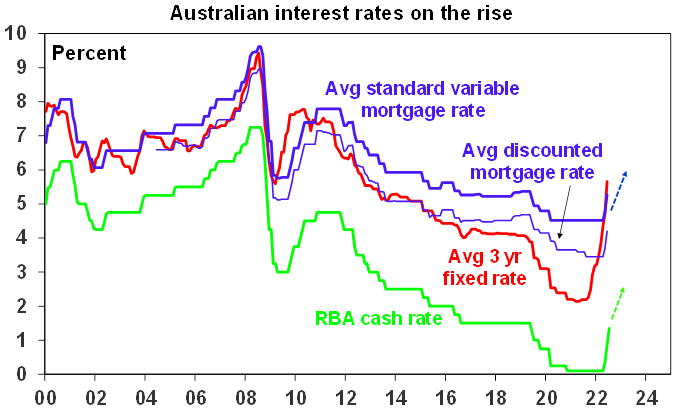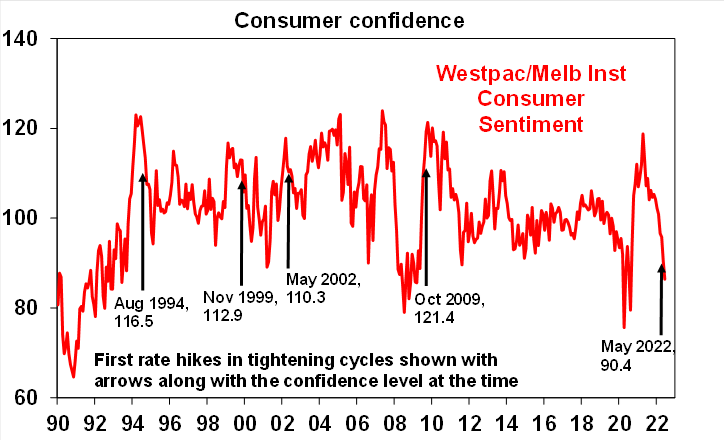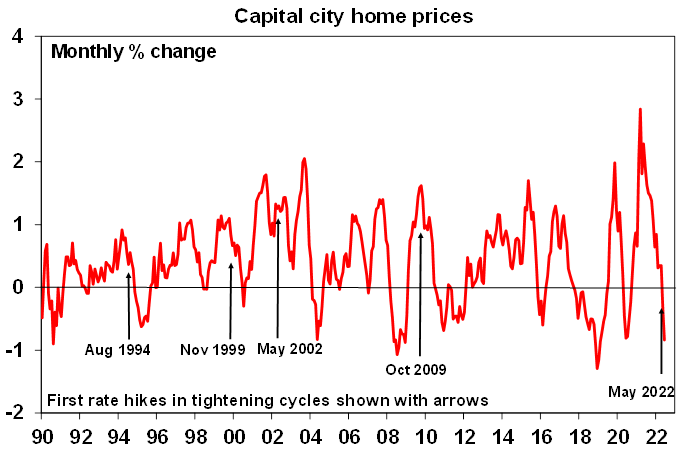Dr Shane Oliver, Head of Investment Strategy & Chief Economist at AMP, discusses the cash rate increase.
Key points:
- The RBA raised the cash rate by 0.5% taking it to 1.35%, as widely expected.
- This is the fastest back-to-back increase in rates since increases of 0.75% and 1% in November and December 1994 respectively.
- The RBA remains upbeat on the economy and employment and remains concerned about the risk of rising inflation expectations,
- We expect the cash rate to peak around 2.5% in the first half of next year as the economy slows faster than the RBA is assuming which will take pressure off inflation. Rate cuts are expected in the second half of 2023.
In justifying the further 0.5% hike in rates the RBA noted that: the economy remains resilient; the labour market is strong with the unemployment rate at 3.9%; the Bank’s business liaison continues to point to higher wages growth; inflation is high with strong demand and a tight labour market playing a role; and it is important that medium term inflation expectations remain “well anchored” or low.
The RBA’s back-to-back 0.5% rate hikes are consistent with the stepped-up pace of tightening from central banks in New Zealand, Canada and the US recently as they all try to get ahead of the surge in inflation and to contain inflation expectations. This and the low starting point explain why the cash rate is being increased at the fastest pace since 1994.
The RBA’s commentary remained hawkish reiterating that it will “do what is necessary” to return inflation to target and indicated that it expects to raise interest rates further.

Source: RBA, Bloomberg, AMP
Banks are likely to pass the RBA’s rate hike on in full to their variable rate customers and deposit rates will rise further. Fixed mortgage rates have already moved up in line with rising bond yields in anticipation of higher cash rates – and are now up two or three-fold from record lows around 2% early last year.
While rate hikes add to the cost of living and won’t fix supply, the RBA has little choice but to “normalise” interest rates for now
Supply constraints – reflecting the impact of the pandemic, the war in Ukraine and the floods – are the main factor behind the rise in inflation and RBA rate hikes won’t boost supply. But the RBA has little choice but to continue the process of tightening monetary policy.
- First, strong Australian demand is also a factor with for example retail sales still running around 15% above their long-term trend. As is the very tight labour market.
- Second, having a still near zero cash rate when unemployment is below 4% and inflation is 5% and rising to around 7% makes no sense.
- Third, the experience from the 1960s and 1970s tells us the longer high inflation persists the more inflation expectations will rise and get built into price and wage setting making it even harder to get inflation back down again without a recession. By raising rates, the RBA is signalling its commitment to get inflation back down to the 2-3% target which will in turn help keep inflation expectations down.
- Finally, the global backdrop now of bigger government, big budget deficits, the reversal in globalisation and the demographic decline in the proportion of workers relative to consumers, all point to a transition from the falling and low inflation world of the last 30-40 years to structurally higher inflation. This means that central banks like the RBA have to be more hawkish than has been the case for some time.
Money market expectations for a cash rate of 3.5% plus are still too hawkish
These considerations still point to more rate hikes ahead. A build up in excess household saving of around $250bn through the pandemic – evident in many households being well ahead on their mortgage payments – imparts a degree of resilience for households which some have argued means that the RBA may have to be a lot more aggressive taking the cash rate to 3.5% or more. And while the futures market has lowered its expectations for the cash rate over the next 12 months from well above 4% it is still factoring in a rise to 3.7%.
However, we remain of the view that the cash rate won’t have to go that high before the RBA achieves its aim of cooling demand enough to take pressure off inflation and keep inflation expectations down.
- First, global supply bottlenecks are showing signs of improvement with reduced delivery delays, lower freight costs and falling metal and grain prices.
- Second, while energy prices are likely to remain high, they may be getting close to their peak so their contribution to ongoing inflation may go to zero later this year.
- Third, many households will experience a significant amount of pain from higher rates. For example, a new borrower with an average $600,000 mortgage will have seen around $420 a month increase in their monthly repayment since April once the latest rate hike is passed through. That’s nearly an extra $5100 a year. Taking the cash rate to 3% would imply an extra $12,200 a year since April in mortgage payments. This is a huge hit to the household budget.
- Fourth, the RBA just wants to slow things down to take pressure off inflation and give time for supply to catch up. It does not want to crash the economy and is not on autopilot. So, it will be watching indicators of spending and things like house prices very closely.
- Finally, it looks like the RBA is getting some traction. While the job indicators and retail sales are still strong these are lagging indicators. By contrast consumer confidence is very weak and is well below where it’s been at this point in past RBA rate hiking cycles. See the next chart.

Source: Westpac/MI, AMP
Likewise national average home prices are falling, whereas at this point in previous RBA rate hiking cycles they were still rising and did not usually start falling until further into the rate tightening cycle. See the next chart

Source: Core Logic, AMP
The earlier than normal hit to confidence and house prices reflects a combination of: higher household debt levels; the fact that this tightening cycle started before the rise in the cash rate with the removal of the 0.1% bond yield target last year which helped drive a sharp rise in fixed mortgage rates; and cost of living pressures that have seen an unprecedented plunge in real wages and hence spending power.
The bottom line is that RBA monetary tightening continues to appear to be getting traction earlier than would normally occur in an interest rate tightening cycle. All of which will start to take pressure off inflation and limit the amount by which the RBA will ultimately need to raise the cash rate by. This is likely to see the cash rate peak well below market expectations for a rise to 3% and beyond.
The RBA will probably hike again by 0.5% in August but thereafter we expect more gradual moves as economic data slows with the cash rate expected to rise to 2.1% by year end with a peak around 2.5% in the first half of next year, ahead of rate cuts in the second half of next year.
Given that the latest RBA hike was roughly in line with our expectations we have made no changes to our cash rate forecasts.
Ends
Important note: While every care has been taken in the preparation of this document, AMP Capital Investors Limited (ABN 59 001 777 591, AFSL 232497) and AMP Capital Funds Management Limited (ABN 15 159 557 721, AFSL 426455) make no representations or warranties as to the accuracy or completeness of any statement in it including, without limitation, any forecasts. Past performance is not a reliable indicator of future performance. This document has been prepared for the purpose of providing general information, without taking account of any particular investor’s objectives, financial situation or needs. An investor should, before making any investment decisions, consider the appropriateness of the information in this document, and seek professional advice, having regard to the investor’s objectives, financial situation and needs. This document is solely for the use of the party to whom it is provided.